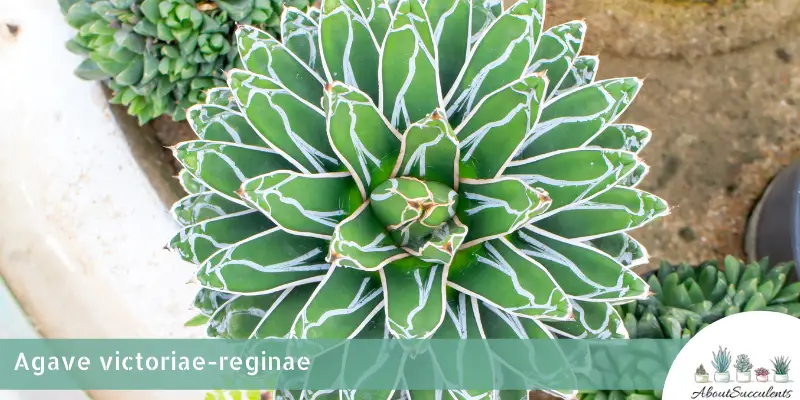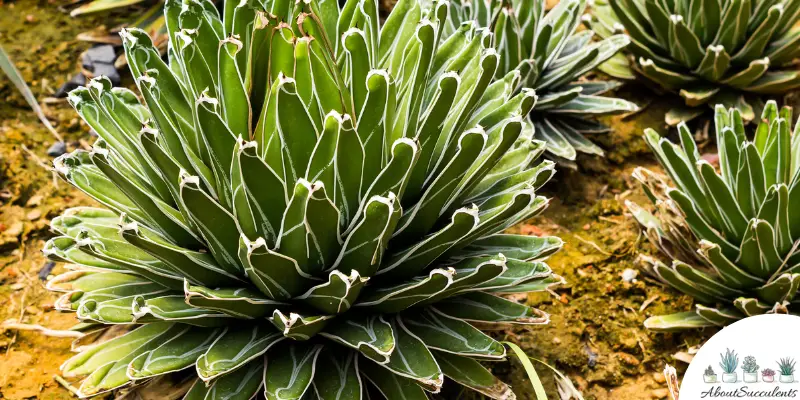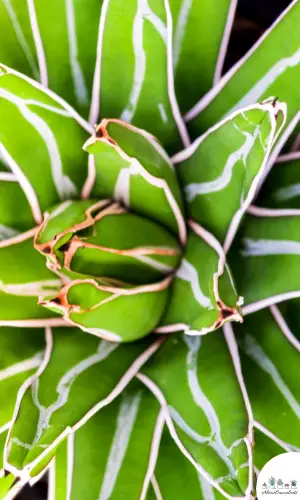
Agave victoria-reginae is a slow-growing succulent that is desired by many horticulturists and landscape artists because of its majestic thick, rigid, and dark-green leaves accented with silvery-white margins.
The magnificent leaves are short and grow from 5 to 7-inches (15 to 20cm) long and inch (3cm) wide and have a terminal spine. When the leaves grow together, they become compact and create a stunning, globular, dark-green rosette.
Similarly, the rosette is slow-growing and while it reaches a height of only 8-inches (22cm), its width can reach 17-inches (45cm).
In the summertime, Agave victoriae-reginae blooms many flowers with different colors but often with hints of purple which is appropriate as the succulent was named after Queen Victoria.
For this reason, Agave victoriae-reginae has been knighted with a variety of noble nicknames such as Queen Victoria Century Plant, Queen Victoria Agave, Royal Agave, and Victoria Agave.
Queen Victoria Century Plant is native to the lower regions of the Sierra Madre Oriental Mountains that are found in the state of Coahuila and on the south side of Nuevo Leon in northeastern Mexico. Queen Victoria Agave succulent is a member of the Agavaceae family.
General Information
Also known as: Queen Victoria Century Plant, Queen Victoria Agave, Royal Agave, and Victoria Agave
Plant Family: Agavaceae
Origin: Mexico
Height: 8-inches (20cm)
Exposure: Partial or full sun for up to 6 hours per day whether grown outdoors or indoors.
Water Needs: Drought-tolerant; use the “Soak and Dry” method where you give the soil a thorough soaking after it has dried out completely.
Soil Type: Succulent soil with added 50% coarse sand, perlite, and pumice for better drainage.
Soil pH: 6.0 to 7.5
How to Grow and Care for Agave Victoriae-Reginae

Agave Victoriae-reginae is a type of succulent plant that’s easy to grow and care for. Queen Victoria Agave doesn’t need the royal treatment. As long as Agave receives its daily dose of sunlight and receives water every now and then, the succulent will remain healthy, happy, and stunning.
Sunlight
Agave Victoriae-reginae needs the sun to produce food, bring out its eye-catching colors, and bloom the lovely flowers.
If you prefer Agave Victoriae-reginae to grace your outdoor garden, plant it in a location that gets up to 6 hours of partial to direct sunlight. Avoid exposing Victoria Agave to the afternoon sun because the intense rays might burn its leaves.
You can plant Victoria Agave in a pot and grow it indoors. In fact, if your region experiences temperature drops below 10 or 15° F (-12 to -9.4 ° C), it would be best to house the succulent in a pot.
Once the mercury falls, bring Royal Agave indoors. Make sure that you place the pot near a window that brings in 4 to 6 hours of partial sun.
If this isn’t possible, you’ll have to buy a Grow Light. Place Agave Victoriae-reginae under the Grow Light for 6 hours per day.
A Grow Light is a worthwhile investment because if your succulent doesn’t get enough sun, it will undergo etiolation. This is a process where the leaves stretch out to look for sunlight. Unless the condition is addressed, the leaves will thin out and eventually, die.
Watering

While ensuring that Agave Victoriae-reginae gets sunlight every day, the opposite is true when it comes to watering.
Follow the “Soak and Dry” method when watering Queen Victoria Century Plant. Using this method, test the soil for dryness.
You can do this by inserting a stick an inch deep into the soil. If the stick feels dry after you pull out, water the soil by giving it a thorough soaking. Never water the plant directly. Only water from below and never from above.
In the summer and springtime, expect to water the soil every seven to 10 days. In comparison, you’ll water the soil less frequently during the winter months because the cold temperature will retain moisture longer.
Pot and Soil
Sure, those glass pots look nice and classy but they’ll also ruin Agave Victoriae-reginae. The best choices are pots made of either unglazed ceramic or terracotta.
The golden rule for taking care of succulents is drainage. You can’t keep the roots of the plant under moist conditions for a long time or else they’ll rot.
Unglazed ceramic and terracotta allow moisture to escape from the soil. The pot should be slightly bigger than the base of Royal Agave in order to have proper soil aeration and to give the roots enough room to grow.
You must also make sure that the pot has a drainage hole at the bottom to let the excess water come out.
Drainage quality is also the order of the day when choosing the ideal soil for Agave Victoriae-reginae. We recommend gritty succulent soil and adding 50% perlite, pumice, or coarse sand to improve the quality of drainage.
How to Propagate Agave Victoriae-Reginae
Agave Victoriae-reginae produces offsets or pups that grow near the base of the plant. You can use the offsets to propagate more of the species.
Offsets Method:
Step 1: Use a sterilized and sharpened knife to help you gently pull out the offsets from the soil.
Step 2: Let the offsets dry out and develop hard calluses. This will take around 2 to 4 days.
Step 3: Once the offsets have hardened, plant them in well-draining soil.
Step 4: Lightly water the soil and position the container near a window that gets 4 to 6 hours of sunlight every day.
Step 5: If the roots have taken hold, only water the plant when the soil is dry.
Frequently Asked Questions
Is Agave Victoriae-Reginae Toxic To Cats and Dogs?
Agave Victoria-regine won’t be found on the list of plants toxic to cats and dogs that appear on the website of the American Society for the Prevention of Cruelty to Animals (ASPCA).
Why Is My Agave Victoriae-Reginae Dying?
We’ve mentioned the importance of drainage when growing and taking care of Agave Victoriae-reginae. If the soil doesn’t drain quickly enough and dries out, it becomes a breeding ground for fungi.
The cells of the roots will rupture leading to root rot and providing an entryway for the fungi to infect the entire succulent.
If your Agave Victoriae-reginae is dying, it could be because of overwatering. Another possibility is pest infestation.
Overwatering
The “Soak and Dry” method is the ideal approach to watering Queen Victoria Agave because the soil is only given water when it has been tested to be 100% dry.
You’ll know that you gave Queen Victoria Agave too much water when you see yellowish discoloration on the previously resplendent dark-green leaves. Don’t waste a second more. Get a pair of sharpened and sterilized garden shears and cut away all of the infected sections.
After you’ve sanitized the cutting tool, turn your focus on the roots. Gently remove the plant from the soil and cut away the roots that have rotted away.
When the plant undergoes infection, it gets traumatized. Give the plant 1-2 days to dry out and recover. Meanwhile, prepare its new home. Get a new pot and fill it with succulent soil.
Replant Agave and wait for 2-3 days before watering the soil. Queen Victoria Agave needs a few days to get used to its new home.
Pest Infestation
Agave Victoriae-reginae attracts mealybugs and scale insects that love to drink the sap from its leaves. These pests will also leave substances that can infect your plant.
You won’t be able to see these insects but if you notice white, cotton-like substances on the leaves, these are telltale signs of the presence of mealybugs.
Remove the substances with a cotton ball soaked in 70% isopropyl alcohol. Spray the plant with diluted neem oil to keep pests away.
Yes, Agave Victoriae-reginae produces flowers in the summertime. The flowers will appear in a variety of colors and have hints of purple. It takes 10 to 15 years for the flowers to bloom. As a monocarpic succulent, Agave Victoriae-reginae will die after blooming.
Last Updated on June 9, 2022 by Sofia Lara